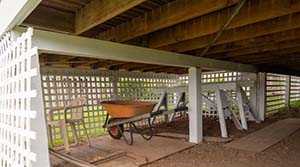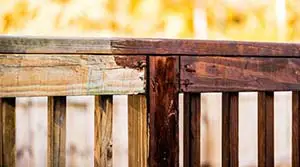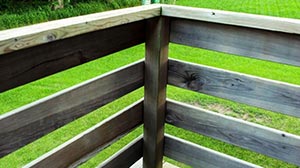
If you are the proud owner of a new deck, you may want it stained. Staining a deck protects the deck and brings out the colors.
A brand-new, shiny deck is the perfect thing for any homeowner to add to their house. However, many homeowners are unsure when they should stain a new deck.
You will know if the deck is dry enough to stain if it passes specific tests or you have waited long enough. You can check moisture levels by using a moisture meter, doing a condensation check, or drizzling water on the deck. Finally, if you stain a new wood deck too soon, you will make it more prone to structural and aesthetic problems.
Read on to discover what happens if you stain a new deck too soon.
What Happens if You Stain a Deck Too Soon?
There are two ways that you can stain a deck too soon.
1. Immediately After it Rained Before Drying
The first is if you stained a deck after it rains but before it dries. If this happens, it will lock moisture in the pores and will make it vulnerable to problems such as:
- Mold
- Fungi
- Mildew
- Wood rot
- Decay
If the stain is left on the deck and not reapplied or treated to prevent these problems, the deck will eventually become very damaged. You might need to replace the deck in its entirety.
2. If the Wood Was Just Pressure Treated
The other way to stain a deck too soon is if you have new deck wood that has just been pressure-treated. It can take up to four weeks to be ready for a stain.
If you stain the deck wood before it ages, the chemicals will still be in the pores and prevent the deck stain from filling the pores to protect the wood. Therefore, the chemicals used in the pressure treatment need time to evaporate.
Alternatively, you can force the pressure treatment out of the wood and open the pores using oxygenated bleach and acid treatment. After using this method, wait for a week before staining the wood.
Regardless of the reason, staining the deck too soon will result in poor protection of the deck wood and open it up to problems, such as insect infestation and water damage.
These problems are harmful in the long term. If the wood damage persists, you may ultimately replace the deck.
Read on to discover how you should check moisture levels in a new deck.
How Do I Check Moisture Levels in a Deck?
A good rule of thumb is to wait 3-4 days after rainfall or 48-72 hours after you pressure wash the deck. Use these methods after this time has elapsed. You should always wait for more time if you doubt how dry the deck is. It is expensive to remove a failed deck stain.
1. Moisture Meter
Before staining a new deck, homeowners should check the moisture levels in a deck using a moisture meter, covering the deck wood with a garbage bag, or drizzling water on the deck. There are two types of moisture meters, pin and pinless.
For a pin moisture meter, follow this procedure:
- Remove the top caps
- Stick the two metal probes into the wood
- Test at low setting
- If nothing shows, switch to high setting
- Test the deck in different areas
For the pinless moisture meter, follow this procedure:
- Put the scanning plate on the wood
- Take the reading in multiple places
The deck wood is still saturated if the reading is 16% WME or higher.
Using a moisture meter is the most accurate of any other method. However, it is the most expensive and time-consuming.
Moisture readers cost more money than garbage bags or water. You need to take multiple readings of different areas of the deck.
For example, the edges might be dry, but the middle of the deck might not be. A pinless meter is the least time-consuming method because it does not need to measure as many places as a pin meter does.
2. Condensation Method
Next, there is the condensation method. To test a new deck using this condensation method, follow the following procedure:
- Put the edge of the lumber in a black garbage bag
- Wait two hours
- See if there is any condensation
The bag will make the wood “sweat” if there is condensation. If it sweats, then the deck wood is too saturated with moisture. It is good to wait until you repeat the test and there is no condensation.
The problem with this method is that it measures just the edge of the lumber. You are not getting any readings anywhere on the deck where the garbage bag does not cover. Therefore, the side of the deck can be dry, but the middle might not be.
3. Water Drizzle Method
Finally, there is the water drizzle method. To test the moisture level of the deck, pour water on the wood and see whether it beads up.
If the water beads up, then the deck is saturated. The saturation indicates that the pores of the deck wood are clogged. You should not apply the stain if the water is not absorbed.
The only problem with this method is that, while it is a visual cue, the test needs to be done on different areas of the deck wood to get a full reading to see which parts of the deck are dry and which parts are too moist.
Read on to discover how to know if your deck is dry enough to stain.
How Do I Know if My Deck is Dry Enough to Stain?
Now that you’ve tested the lumber in the deck with the moisture detecting levels, here is how you interpret the results:
| Method | Pass Condition |
|---|---|
| Moisture Meter | If the moisture in the wood is within 1-15% WME, then it is ready. |
| Condensation | If no condensation happens in the black garbage bag, it is ready. |
| Water Drizzle | If the water is absorbed, then it is ready. |
Of the three, the moisture meter is the most accurate method and the most expensive. The water drizzle method is the cheapest and the most visual. Finally, the condensation method is the least desirable because it is the least accurate and the second most expensive.
Generally, you should wait 3-4 days after rainfall or 48-72 hours after you pressure wash the deck. You should use these methods after these periods have elapsed.
Since it is expensive to remove deck stain if applied and the coat fails, you should always wait longer when in doubt.
Read on to discover the best type of moisture meter to use to measure the wetness of deck wood.
What is the Best Type of Moisture Meter to Measure How Wet My Deck is?
There are two types of moisture meters. The type of moisture meter you use depends on your preference and situation. These two types of meters, pin and pinless, will measure moisture at different depths.
1. Pin Moisture Meter
A pin moisture meter needs to have its metallic sensors penetrate the wood. It uses resistance technologies that can be affected by the chemical composition of the wood. The reading may also require mathematical adjustment depending on the temperature.
2. Pinless Moisture Meter
A pinless moisture meter uses a sensor pad and uses electromagnetic technology. It can be used for depths of 0.25” to 0.75”. It’s also easier and faster to use, requires fewer tests, and never penetrates the surface of the deck wood.
Therefore, a pin meter is better for measuring very thick wood, while a pinless moisture meter is better for measuring thin wood.
A pin meter will also cause slight indentations in the wood, but a deck stain will fill the pores left by the meter, so there will be no lasting damage.
Read on to discover the best moisture meters to use to measure the dampness of your deck wood.
What are the Best Moisture Meters to Use to Measure the Dampness of My Deck Wood?
If you choose to measure the moisture in your deck using a moisture meter, many different types of meters are available. Some will use other batteries, while others might have different screens.
We chose 3 of the highly-ranked moisture meters for measuring wood and compared them:
| Moisture Meter | Type of Meter | Additional Features & Notes |
|---|---|---|
| AZUNO Moisture Meter | Pin | – Uses 2 AAA batteries – Measures temperature – Backlit LCD |
| Dr.meter Moisture Meter | Both pin and pinless varieties | – Uses 9V battery – Measures Temperature – Green backlit display |
| Tavool Digital Moisture Meter | Pin meter | – Uses 2 AAA batteries – Measures temperature – LED Display |
There are two primary differences between the three moisture meters:
- The type of battery they use.
- The type of displaces they have.
The type of batter is either 9V or AAA. The kind of display they have is a backlit LCD, an LED, or a green backlit display. Since all three have pin varieties, we recommend pin meters over pinless meters.
The moisture meters also measure the temperature of the wood, so you will not need another device. It is crucial to measure the temperature of the wood.
If you apply deck stain when the wood is too hot, the deck stain can also fail. You would then have to remove the stain and reapply it.
The same is also true if the deck wood is too cold. The can of deck stain directions should state the ideal temperatures for using the product.
Final Thoughts
There are two main reasons why you should wait before staining your deck:
- The first reason is that you can damage your deck and trap in water and other things that can cause damage. This damage could lead to deck rot, among other problems, and lead to needing your entire deck replaced.
- The other reason is that a new pressure-treated deck will not absorb the stain until the pressure treatment chemicals evaporate.
The chemicals will still clog the wood pores, which will make it impossible for the deck stain to fill the pores to protect the deck.
After it rains on your new deck, you should check the moisture levels of the deck. You can do this using the condensation method, the water drizzle, and the moisture meter reading.
The moisture meter reading is the most accurate but the most expensive. The water drizzle method is the most visual, while the condensation check does not give as much information as the other two methods.
We recommend a pin meter because three highly-rated meters are pin meters. A pinless meter, however, measures moisture at shallower depths. The three moisture meters that we recommend will also measure the temperature of the wood.
The temperature is also a crucial measurement because if the deck wood is too hot, the stain will not hold and will have to be removed and reapplied.
The same is also true if the wood is too cold. Follow the directions on the product container to figure out what temperature your wood should be before you apply it.
Finally, whether you choose a pin or pinless meter to measure the moisture, the deck must be dry or old enough to stain. If the deck is not dry or old enough and you still stain the deck, this can result in damage that will require replacing the entire deck.
Sources
- Testing Wood For Moisture Content Before Staining | Eco Star Painting
- Moisture Content of Deck When Applying Stain | Best Deck Stain Reviews Ratings (deckstainhelp.com)
- Wood Moisture Meters [2021 Guide] Pinless vs Pin (wagnermeters.com)
- Learn how long to wait after washing your deck to stain or paint it for a long-lasting space! – DecksDirect













